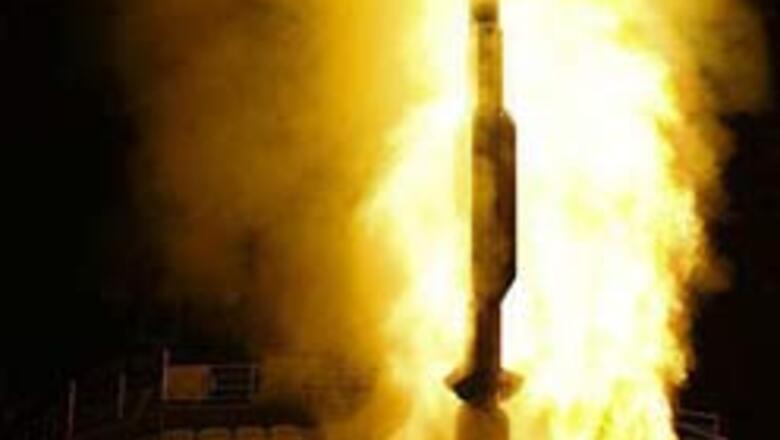
views
Washington: A missile launched from a US Navy cruiser soared 130 miles (210 kilometers) above the Pacific and smashed a dying and potentially deadly US spy satellite, the Pentagon said. Two defence officials said it apparently achieved the main aim of destroying an onboard tank of toxic fuel.
Officials had expressed cautious optimism that the missile would hit the satellite, which was the size of a school bus.
But they were less certain of hitting the smaller, more worrisome fuel tank, whose contents posed what Bush administration officials deemed a potential health hazard to humans if it landed intact.
In a statement late on Wednesday announcing that the attack on the satellite, the Pentagon said, "Confirmation that the fuel tank has been fragmented should be available within 24 hours."
It made no mention of early indications, but two defence officials close to the situation said later that it appeared the fuel tank was hit. One said observers saw what appeared to be an explosion, indicating that the tank was hit.
Because the satellite was orbiting at a relatively low altitude at the time it was hit by the missile, debris will begin to re-enter the Earth's atmosphere immediately, the Pentagon statement said.
"Nearly all of the debris will burn up on re-entry within 24-48 hours and the remaining debris should re-enter within 40 days," it said.
The USS Lake Erie, armed with an SM-3 missile designed to knock down incoming missiles - not orbiting satellites - launched the attack at 2226 p.m. EST Wednesday (0326 GMT Thursday), according to the Pentagon.
It hit the satellite about three minutes later as the spacecraft traveled in polar orbit at more than 17,000 mph (27,000 kilometers per hour).
The Lake Erie and two other Navy warships, as well as the SM-3 missile and other components, were modified in a hurry-up project headed by the Navy in January.
The missile alone cost nearly $10 million, and officials estimated that the total cost of the project was at least $30 million.
The launch of the Navy missile amounted to an unprecedented use of components of the Pentagon's missile defence system, designed to shoot down hostile ballistic missiles in flight - not kill satellites.
The operation was so extraordinary, with such intense international publicity and political ramifications, that Defence Secretary Robert Gates - not a military commander - made the decision to pull the trigger.
PAGE_BREAK
Gates had arrived in Hawaii a few hours before the missile was launched. He was there to begin a round-the-world trip, not to monitor the missile operation. His press secretary, Geoff Morrell, told reporters traveling with Gates that the defence chief gave the go-ahead at 1340 p.m. EST (1840 GMT) on Wednesday while en route from Washington.
Morrell said Gates had a conference call during the flight with Air Force Gen. Kevin Chilton, head of Strategic Command, and Marine Gen. James Cartwright, vice chairman of the Joint Chiefs of Staff.
They told him that "the conditions were ripe for an attempt, and that is when the secretary gave the go-ahead to take the shot, and wished them good luck," Morrell said.
At 2235 p.m. EST (0335 GMT Thursday), Gates spoke to both generals again and "was informed that the mission was a success, that the missile had intercepted the decaying satellite, and the secretary was obviously very pleased to learn that," said Morrell.
The government organized hazardous materials teams, under the code name "Burnt Frost," to be flown to the site of any dangerous or otherwise sensitive debris that might land in the United States or elsewhere.
Also, six federal response groups that are positioned across the country by the Federal Emergency Management Agency were alerted but had not been activated Wednesday, FEMA spokesman James McIntyre said before the missile launch. "These are purely precautionary and preparedness actions only," he said.
President George W Bush gave his approval last week to attempt the satellite shootdown on grounds that it was worth trying to destroy the toxic fuel on board the satellite before it could possibly land in a populated area.
The three-stage Navy missile, designated the SM-3, has chalked up a high rate of success in a series of tests since 2002, in each case targeting a short- or medium-range ballistic missile, never a satellite.
A hurry-up program to adapt the missile for this anti-satellite mission was completed in a matter of weeks; Navy officials said the changes would be reversed once this satellite was down.
The government issued notices to aviators and mariners to remain clear of a section of the Pacific Ocean beginning at 2030 p.m. EST Wednesday (0330 GMT Thursday), indicating the first window of opportunity to launch the missile.
Having lost power shortly after it reached orbit in late 2006, the satellite was out of control and well below the altitude of a normal satellite.
The Pentagon determined it should hit it with an SM-3 missile just before it re-entered Earth's atmosphere, in that way minimizing the amount of debris that would remain in space.
Left alone, the satellite would have been expected to hit Earth during the first week of March.
About half of the 5,000-pound (2,300-kilogram) spacecraft would have been expected to survive its blazing descent through the atmosphere and would have scattered debris over several hundred miles (several hundred kilometers).




















Comments
0 comment